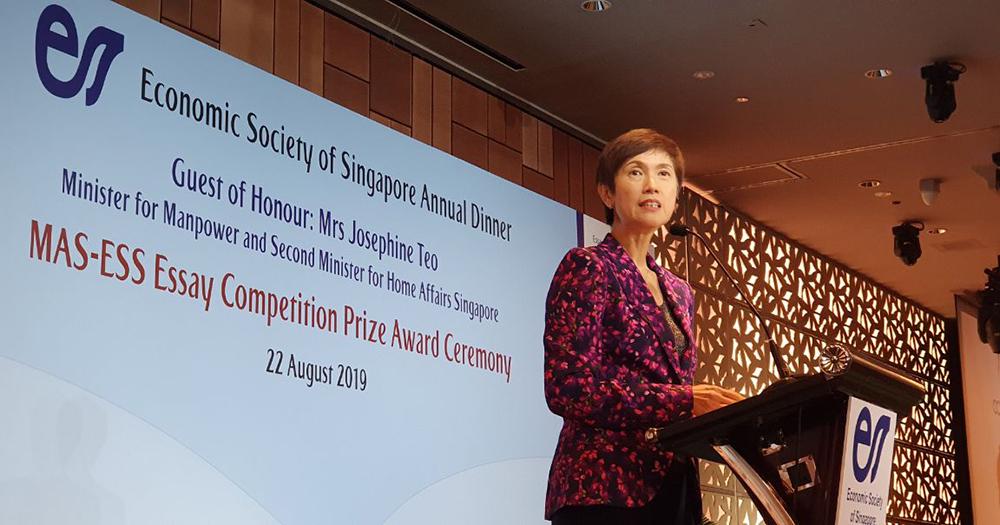The Retirement Age Act (RAA) prevents employers from prematurely dismissing workers because they are old.
This was one of the main points mentioned by Minister for Manpower Josephine Teo at the annual dinner of the Economic Society of Singapore on August 22, at the Mandarin Orchard hotel.
Teo said that the RAA provided legal protection for older workers but did not take away an older worker's freedom to stop working if he or she wishes to do so.
Teo went on to explain how a vision of "productive longevity" was behind the recommendations made by the Tripartite Workgroup on Older Workers.
Why a retirement age set into law matters
Teo highlighted that prior to the Act's introduction in 1993, an employer could retire a worker at any age, with many companies typically retiring their workers at 55.
Teo noted that even when the government encouraged employers and unions in 1988 to voluntarily raise their company-specific retirement ages from the norm of 55 to 60, only about 10 per cent did so.
Hence, the introduction of RAA in 1993 provided legal means of preventing an employer from retiring or dismissing a worker simply because he has reached a certain age, below the stipulated age of 60 at that time.
The retirement age was subsequently raised to 62 in 1999.
The Tripartite Workgroup to study the issue of older workers has since recommended the retirement age to be raised to 65 by 2030.
In reiterating her point, Teo stated:
"The 'abolitionists' may not have realised that when the statutory Retirement Age is removed, so too the employer's legal obligation. We will then regress back to the days before 1993."
She noted that ageism was still present, despite employers being more receptive to hiring and keeping older workers, and added that this was why the unions have called for the retirement age to be raised, not removed.
Re-employment age introduced to balance needs of employers
Teo further clarified however, that the needs of workers had to be balanced against the needs of employers.
This was where the concept of re-employment came in.
Noting that the concept was pioneered in Japan, Teo explained that re-employment obliges employers to offer re-employment contracts to older workers who have reached the retirement age.
However, Teo said that after reaching the retirement age, the worker would be offered a job but not necessarily the same job or the same pay.
With regard to the Re-employment Age Act, Teo pointed out that it was first announced in 2007, then legislated in 2012, with employers having to offer re-employment to eligible employees from 62, up to the re-employment age of 65.
This age was then raised by two years, to 67 in 2017, and has been recommended by the Tripartite Workgroup to be raised to 70 by about 2030.
S'poreans don't need to work until they reach retirement or re-employment ages
Teo further clarified however, that this did not mean people had to work until the retirement or re-employment age either.
Moreover, the CPF withdrawal age is not tied to the retirement age or re-employment age.
Here, Teo added that CPF members are able to withdraw part of their savings.
Moreover, at the age of 65, members can start to receive their remaining savings in monthly payouts.
She said that this meant people have the choice to stop working before reaching the retirement or re-employment age.
Government’s vision of productive longevity
After explaining the context of Singapore's approach to senior employment and its retirement and re-employment framework, Teo proceeded to articulate government's vision of productive longevity.
This is because Singapore's citizen population aged 65 and above are expected to double to almost 900,000 by 2030, and elderly citizens want the option to continue working.
She subsequently highlighted why the government's vision of productive longevity is an economic, social and political vision.
Economic vision
Teo said that economically, Singapore’s growing pool of older workers are a resource which businesses can tap on.
As such, this resource pool can potentially bring some relief to a tight labour market, and help employers better meet their manpower needs.
In addition, work for the individual produces income and improves their retirement adequacy.
Social vision
In this aspect, Teo said that socially, work provides a natural community for the individual to be part of.
People of all backgrounds, ethnicities and ages come together for a common cause in work.
The engagement and sense of purpose derived from work contributes to the health of Singapore’s older workers.
Furthermore, it acts as an integral part of a person’s identity.
On this matter, Teo cited a study by Duke-NUS Medical School, which found that older Singaporeans who continued to work generally fared better in terms of psychological, physical, and functional health than those who had retired.
Political vision
Teo said that "productive longevity" is a political vision as it is a choice by the government to treat its ageing workforce as an opportunity and not a burden.
As for achieving this vision, Teo stated that it was necessary for employers to do their part to develop inclusive workforces and productive workplaces.
At the same time, Teo added that workers also need to be willing to adapt, to reskill and move into new roles.
Meanwhile, the government must support workers and businesses, such as helping businesses to reduce the medical cost, to improving health and safety measures as a result of an older workforce.
Teo added that the Workgroup’s recommendation of a package of wage offsets have since been accepted by MOM, and will be shared in Budget 2020 by Deputy Prime Minister Heng Swee Keat.
Top photo by Julia Yeo
If you like what you read, follow us on Facebook, Instagram, Twitter and Telegram to get the latest updates.
